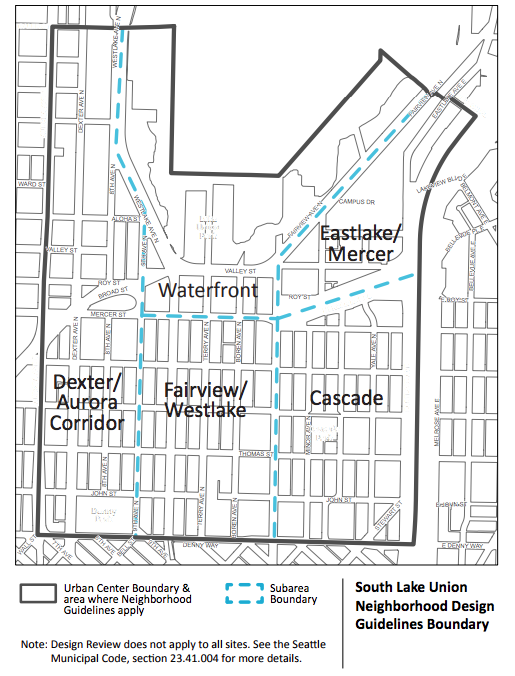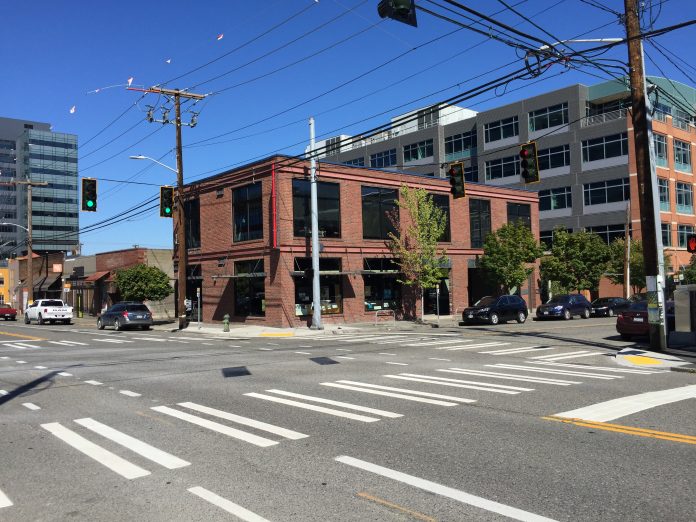Last week, the Seattle Office of Planning and Community Development released draft changes for the South Lake Union design guidelines. That guidelines have been in place 2005 and were last revised in 2013. Since then, rapid growth has taken hold across the neighborhood in the form of new development, several critical zoning changes have been made, and streetscape plans adopted, so the context is fairly different. The existing guidelines are quite a bit thinner and shorter than the proposed changes.

The 2018 update would make several consequential changes, which include:
- Mandating consistency with neighborhood-level guidance on active transportation design and exterior design concepts for buildings;
- Removing a mandate for consistency with neighborhood-level guidance on project use and activities design (this would still need to be consistent with citywide guidance);
- Adding a new subarea (Eastlake/Mercer), renaming others, and extending the Aurora Corridor (Dexter/Aurora Corridor under the changes) further north; and
- Provide much greater detail about objectives in each of the nine guideline sections.
The overall applicability of the design guidelines are intended to remain the same across the geographic area of the South Lake Union Urban Center but with changes to the subareas.
The design guidelines touch on three general areas of urban design, which entail context and site (e.g., urban form and patter, architectural context and character, and natural features), public life (e.g., walkability, street-level relationship, active transportation, and open space connectivity), and design concept (e.g., open space, architectural, and uses).
To give a sense of the types of changes made to sections, the following shows existing and proposed language in the design guidelines:
The new section on active transportation seeks to clarify that transit facilities occurring outside of the right-of-way will be subject to design review. This important because King County Metro Transit is looking to create “bus hubs” in South Lake Union in the coming years, but light rail stations and other transit facilities might also be possible.
“On Class I Pedestrian Streets required street level uses are essential to achieving the intent of Pedestrian Street Classifications,” the guidance notes for transit facilities. “Operational needs may require that vehicle entrances to transit facilities be wider than permitted for parking garages and facade lengths may be greater than other structures in the neighborhood. Street frontage of these projects should maintain and reinforce the levels of pedestrian activity that Class I Pedestrian streets are intended to achieve.” The guidance also notes that “bus hubs” should be fully screened from public view and “[i]deally other uses other uses with transparent, active storefronts are located between bus parking and the public right-of-way.”

The section on project uses and activities would be eliminated in its entirety. The existing guidance, however, for this address parking lots near sidewalks. The desired design approach in such situations is to provide parking below grade. The citywide design guidelines generally state that all parking is encouraged to be located below ground whether located near a sidewalk or not.
A new section on exterior elements and finishes of buildings would provide deeper supplemental guidance on the topic. For building design, the guidance specifically addresses how to use glass for ground floor transparency, quality of facade panel materials, and techniques to resist vandalism and improve visual interest for ground floor facade materials. The preferred approach to selecting and installing trees, landscaping, and hardscaping materials is also identified in the section.
The proposal is open for public comment through February 28th under the State Environmental Policy Act process.
Stephen is a professional urban planner in Puget Sound with a passion for sustainable, livable, and diverse cities. He is especially interested in how policies, regulations, and programs can promote positive outcomes for communities. With stints in great cities like Bellingham and Cork, Stephen currently lives in Seattle. He primarily covers land use and transportation issues and has been with The Urbanist since 2014.



